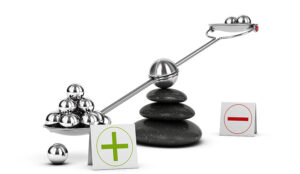Yitzy Tannenbaum at NICE looks at the pros and cons of employee competition.
Humans are naturally competitive. If you look around society, you’ll see the echoes of competitive behavior everywhere. But it’s not always a productive use of our energy. Competition is one of those things that can bring out the best in us and the worst in us, depending on the context and what it’s trying to achieve.
In a work setting, this is also the case. Most organizations look to use competition between employees to encourage more productivity and higher quality work.
Sales teams might use a leaderboard to track conversion statistics, team leaders might nominate an ‘employee of the month’ to recognize someone who has overperformed, or a company might offer innovation incentives for people executing on new ideas.
When done well, these competitions can be significant motivators that push your company to new heights that even your employees didn’t realize were possible. In this article, we’ll explore some of the key pros and cons of employee competitions and how you can leverage them to your advantage.
The Pros of Employee Competitions
Here are some of the key benefits of competition between employees:
- Incentivizes Better Performance
We are social creatures and we naturally have a competitive streak that kicks in when we compare ourselves to others. Employee competitions are a great way to harness that power to motivate your staff to improve themselves and the work that they produce.
Often, it’s only through competition that employees realize just what they can accomplish if they focus their efforts.
- Recognizes and Appreciates Work Performance
Work can be demoralizing if you aren’t getting the validation and appreciation that you deserve for your hard work. Competitions create opportunities for your company to recognize and appreciate your high-performing employees – which helps with morale and loyalty.
- Creates Role Models
Competitions provide opportunities for employees to identify those people who are shooting the lights out so that they can emulate their success. These role models act as north stars that pull everyone else to improve their work performance.
- Retains High Performers
We know that high performers are worth their weight in gold, but because of their track record they often have a range of other work opportunities at their fingertips. Competition rewards are a great way to retain these people and keep them at your organization.
This has never been more important as we wade through ‘The Great Resignation’, a macro response to how the pandemic has changed our view on work.
All of these benefits are valuable in creating the sort of work culture that is continuously improving. There are compounding effects here that can transform your organization for the better.
Now, let’s look at some of the potential downsides of these competitions.
The Cons of Employee Competitions
As with all things, there are certain drawbacks that you should be aware of if you’re looking to create competitions in your organization:
- Damages the Morale of Some Underperforming Employees
Those people who are not doing well in the competitions are at risk of becoming unhappy and resentful. While some will take up the challenge, others might get defensive and shut down entirely.
- Tall Poppy Syndrome
When competitions go too far, you might find that your employees root for each other to fail – in their own self-interest.
If this tendency isn’t checked at the door, your company can fall victim to tall poppy syndrome, where high performers are cut down at their knees – invalidating the overall impact of the competition for the company.
- May Create Classes Within the Organization
There is a risk that competitions create classes of employees within your company, which doesn’t lend itself to efficient collaboration. Your competitions should never come at the expense of group cohesion and camaraderie.
- Can Create an Unhealthy Work Culture
If competition becomes the number one value in your organization, it can become toxic because the only goal is to win. There needs to be balance coming from other values and ideals to keep things healthy and vibrant for everyone.
These downsides are manageable if you’re aware of them and take steps to mitigate their impact. But this requires intentional action and conversation with your employees to manage expectations and set the right tone throughout any competition that you run.
Making the Most of Employee Competitions
Now that we’ve highlighted the potential pros and cons, here are our recommendations for how to leverage competitions and get the most out of them:
- Provide Support for Employees Who Are Underperforming
It’s crucial that you work with those lower-ranking employees to help them identify where they can improve and help them get to the next level. This gives them a better chance to compete and shows that you are investing in everyone.
- Have Varied Competitions That Reward Different Things
You want to ensure that everyone has a chance to win something after a while, and the way you can do this is by having different types of competitions that have different success criteria. This also keeps things fresh and dynamic which is important to maintain buy-in.
- Include a ‘Most Improved’ Award
You also want to recognize people who have made large improvements, and not just those who are at the very top. This encourages everyone to focus on continuous improvement, which is a valuable mantra for your company to have.
- Ensure That the Competition Is Fair
This should go without saying, but many companies still get this wrong because they have certain blind spots. Take your time to work through each aspect of the competition and be sure to consult with the stakeholders to make sure that everything is fair and above board.
- Stop if It’s Doing More Harm Than Good
Assess how your competition is impacting your organization and don’t keep doing it if it’s having harmful effects. Rather pause the competitions and re-imagine how they could be improved, so as not to damage morale further.
If you can take these principles into account, you should be able to use competitions productively to transform how your organization and its people perform. They are immensely powerful when done well and while that takes some thoughtful execution, it’s well worth the investment of time and money.
This blog post has been re-published by kind permission of NICE – View the Original Article
For more information about NICE - visit the NICE Website
Call Centre Helper is not responsible for the content of these guest blog posts. The opinions expressed in this article are those of the author, and do not necessarily reflect those of Call Centre Helper.
Author: NICE
Published On: 12th Nov 2021 - Last modified: 16th Nov 2021
Read more about - Guest Blogs, NICE






 NICE is a leading global enterprise software provider that enables organizations to improve customer experience and business results, ensure compliance and fight financial crime. Their mission is to help customers build and strengthen their reputation by uncovering customer insight, predicting human intent and taking the right action to improve their business.
NICE is a leading global enterprise software provider that enables organizations to improve customer experience and business results, ensure compliance and fight financial crime. Their mission is to help customers build and strengthen their reputation by uncovering customer insight, predicting human intent and taking the right action to improve their business. 































